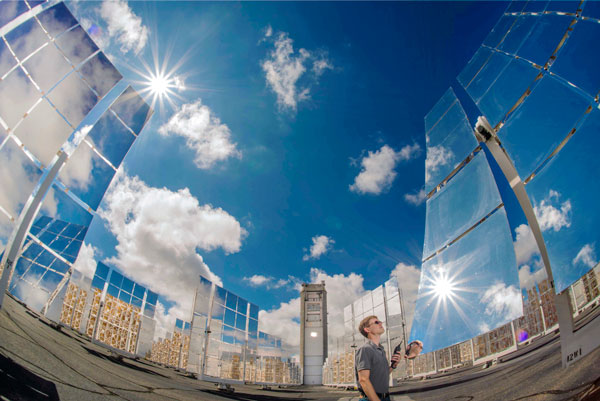Solar tower exposes materials to intense heat to test thermal response
Sandia’s solar tower is helping to assess how extreme temperature changes affect materials.
The tests for the Air Force, now in their second year, take advantage of the ability of Sandia’s National Solar Thermal Test Facility to simulate a very rapid increase in temperature followed by an equally rapid decrease. Testing will continue for at least another year.
Researchers put a 4-by-4-inch sample of a composite material, called a coupon, into a test chamber, then expose it to a burst of intense heat. Different coupons are made of different types of materials.
Specialty ovens can reach the temperatures needed, but ovens can’t heat up or cool down rapidly. “And it’s hard to just stick a coupon in real fast and then take it out,” test engineer Josh Christian said. “Our facility is really good at providing a fast ramp rate for these heating curves, and we also can produce a trailing curve by moving our mirrors in such a way to remove the heat from the sample.”
The solar tower team places the coupon flush to a wall of a test chamber, basically a box, facing a quartz window that lets in the heat produced by the heliostats, or mirrors. The tests, which use about a quarter of the heliostat field, can change heat levels as needed.
Initially, the team closes sliding shutters in front of the window. They focus reflected light from the heliostats onto a calibration panel and use a heat flux gauge to measure the power that will hit the sample. Then they move that reflected light onto the shutters. When ready, the shutters slide open and close very quickly to produce the heating curves needed on the sample. At the same time, a wind tunnel with a blower on one end forces air across the sample to simulate convective cooling. Convective cooling impacts the heating rate since with convective cooling, materials survive longer under intense heat.
Sample could be heated several times
Researchers can subject a sample to heat multiple times to establish material response thresholds after exposure.
“The heat goes in, we close, that’s the end of the test,” Josh said. “We do this repeatedly, 10 to 30 times a day.”
Before and after a test, another Sandia team checks the sample with a 3D scanner, which determines whether the heat produced bubbles or texture changes in the material, Josh said.
Still another group of Sandia researchers takes reflectivity measurements — how much light is reflected from the surface. For example, if a sample absorbs 90 percent of the light and reflects 10 percent, then 10 percent of the light did not heat it. Josh said that’s important because, in real life, materials with a high reflective value heat up slower.
A third team uses nondestructive methods to look inside the sample after a test, checking for changes below the surface, which is particularly important for complex structures made of several different materials.
Testing continues all year
Tests go on year-round, but the Air Force program does not test every day since the solar tower does tests for other programs. Last summer, for example, Josh estimated 30 to 40 days were devoted to the project. Tests continue in the winter, but test periods are shorter due to the angle of the sun to the mirrors.
“For our facility, this is a major test that has started to become routine as we have tested hundreds of samples,” said Josh, who has worked at the tower for eight years.

The project also has led to improvements at the facility, including a new tracking algorithm for the heliostats and advances in heat flux characterization techniques that allow researchers to quantify the heat applied to samples. Knowing the exact heat applied is critical to understand what conditions materials can survive, and researchers developed new tools to help perform that analysis.
The mirrors move with the sun to keep a reflected spot on the solar tower, “but we were finding that at certain times of the year and times of the day, the spot wouldn’t be where we predicted it to be because of imperfections in how the mirrors were installed,” Josh said. So, he said, the improved tracking algorithms not only help the Air Force project but also other Sandia tower projects and potentially other facilities that use heliostats, such as sites that generate power.
The tower has done similar tests for other agencies, including NASA, and other projects for the Air Force. “Now it’s become a success on our side as well as their side,” Josh said.